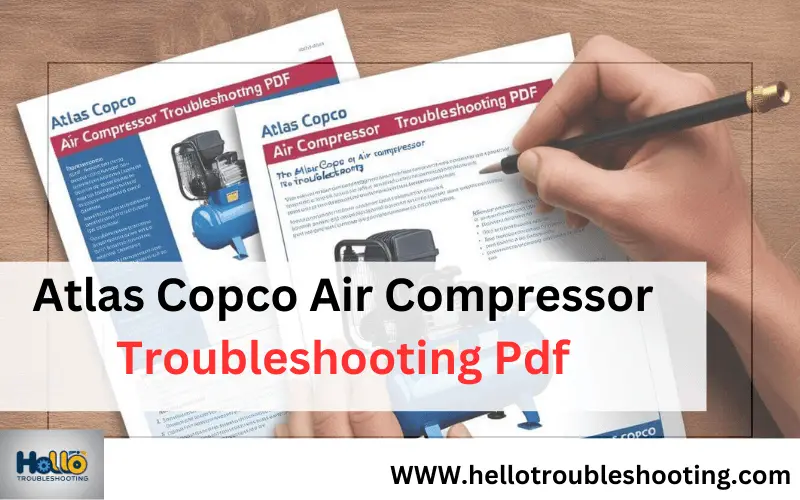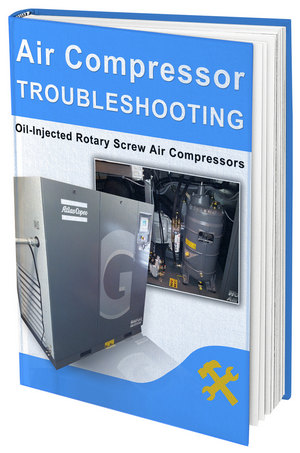The Atlas Copco Air Compressor Troubleshooting PDF provides detailed guidance on diagnosing and fixing common compressor issues. It ensures optimal performance and longevity.
Understanding how to troubleshoot your Atlas Copco air compressor can save you time and money. Proper maintenance and timely fixes are crucial for ensuring your equipment runs efficiently. The troubleshooting PDF offers step-by-step instructions, making it easier to identify and resolve problems.
Common issues include air leaks, pressure drops, and electrical faults. By following the guide, you can address these problems swiftly and effectively. This resource is invaluable for both novice and experienced users. It helps maintain the reliability and performance of your air compressor, ensuring your operations run smoothly.

Introduction To Atlas Copco Air Compressors
Atlas Copco Air Compressors are known for their reliability and efficiency. These machines are used worldwide in various industries. Understanding their features and history can help in troubleshooting and maintenance.
Brief History
Atlas Copco was founded in 1873 in Sweden. It started as a manufacturer of railway products. Over time, it expanded into air compressors and other industrial tools. Today, Atlas Copco is a global leader in compressed air solutions.
Key Features
Atlas Copco Air Compressors come with several key features:
- Energy Efficiency: These compressors use advanced technology to save energy.
- Durability: Built to last, they perform well under tough conditions.
- Quiet Operation: Designed to operate with minimal noise, making them suitable for various settings.
- Easy Maintenance: Simple design allows for quick and easy maintenance.
- Advanced Control Systems: Modern control systems offer precise control and monitoring.
Here’s a table summarizing these key features:
| Feature | Description |
|---|---|
| Energy Efficiency | Uses advanced technology to save energy. |
| Durability | Performs well under tough conditions. |
| Quiet Operation | Operates with minimal noise. |
| Easy Maintenance | Allows quick and easy maintenance. |
| Advanced Control Systems | Offers precise control and monitoring. |
Common Issues
Atlas Copco air compressors are known for their reliability. Yet, like all machines, they can face issues. This section covers two common problems: low pressure and overheating.
Low Pressure
Low pressure in an air compressor can disrupt operations. Here are the main causes:
- Blocked filters: Dust and debris can clog filters, reducing airflow.
- Leaky hoses: Small holes or cracks in hoses can cause air leaks.
- Faulty pressure switch: A malfunctioning switch can misread pressure levels.
Regular maintenance can help prevent these issues. Check and clean filters monthly. Inspect hoses for damage and replace them if needed. Verify the pressure switch is working correctly.
Overheating
Overheating is another common issue with air compressors. It can cause major damage. Here are some reasons for overheating:
- Poor ventilation: Restricted airflow can cause the compressor to overheat.
- Dirty cooling fins: Dust and grime on cooling fins can hinder heat dissipation.
- Low oil levels: Insufficient lubrication can increase friction and heat.
To prevent overheating, ensure the compressor is in a well-ventilated area. Clean cooling fins regularly to remove dust. Check oil levels frequently and top up as needed.
Basic Troubleshooting Steps
Dealing with an Atlas Copco air compressor issue can be daunting. This guide simplifies the Basic Troubleshooting Steps for you. Follow these steps to identify and resolve common problems.
Initial Inspection
Start with an initial inspection. Ensure the compressor is properly connected to a power source. Check for any visible damage or leaks.
- Verify power connections.
- Look for oil or air leaks.
- Inspect the air filter for clogging.
Safety Precautions
Always follow safety precautions to prevent accidents. Ensure the compressor is switched off before starting any inspection or repair.
- Turn off the power supply.
- Release any built-up pressure.
- Wear protective gloves and eyewear.
Refer to the Atlas Copco air compressor troubleshooting PDF for detailed instructions. This PDF will guide you through specific problems and solutions. Keep this document handy for quick reference.

Credit: courses.air-compressor-guide.com
Advanced Troubleshooting
Advanced troubleshooting of an Atlas Copco air compressor can be complex. This guide focuses on common issues and their solutions. With a detailed understanding, you can resolve problems efficiently. Let’s dive into the most frequent electrical and mechanical issues.
Electrical Problems
Electrical problems can cause your air compressor to malfunction. Key issues include:
- Power Supply Issues: Ensure the power supply is stable. Check for any loose connections.
- Tripped Breakers: A tripped breaker can halt operations. Reset the breaker and ensure it stays on.
- Faulty Wiring: Inspect all wiring for wear and tear. Replace any damaged wires.
- Motor Overload: Motors can overheat and shut down. Allow the motor to cool and restart.
Use the table below for a quick reference on electrical issues:
| Issue | Solution |
|---|---|
| Power Supply | Check connections and voltage levels |
| Tripped Breakers | Reset breaker and monitor |
| Faulty Wiring | Inspect and replace wiring |
| Motor Overload | Cool and restart motor |
Mechanical Failures
Mechanical failures can significantly impact performance. Common mechanical issues include:
- Worn-out Bearings: Bearings can wear out over time. Replace worn bearings promptly.
- Air Leaks: Air leaks reduce efficiency. Use soapy water to detect leaks and seal them.
- Broken Valves: Valves can break and cause malfunctions. Inspect and replace broken valves.
- Damaged Belts: Belts can crack or snap. Replace damaged belts to maintain performance.
Addressing these mechanical failures ensures your compressor runs smoothly. Regular maintenance is crucial for longevity.
Maintenance Tips
Maintaining an Atlas Copco air compressor ensures its longevity and efficiency. Regular maintenance can prevent costly repairs and downtime. Below are some essential maintenance tips to keep your compressor in top shape.
Regular Servicing
Regular servicing is crucial for the optimal performance of your air compressor. Follow the manufacturer’s guidelines for service intervals. Ensure all parts are checked and replaced as needed. Create a service log to track maintenance activities.
| Service Activity | Frequency |
|---|---|
| Oil Change | Every 3 months |
| Filter Replacement | Every 6 months |
| Belt Inspection | Monthly |
Cleaning Procedures
Cleaning your compressor regularly prevents dust and debris buildup. Use a soft brush to clean the exterior. Ensure the air intake vents are free of obstructions. Clean the cooling fins with compressed air to avoid overheating.
- Check and clean air filters weekly.
- Inspect and clean the oil separator every three months.
- Wipe down the exterior with a damp cloth monthly.
Following these maintenance tips keeps your Atlas Copco air compressor running smoothly. Regular servicing and cleaning extend its life and efficiency.
Tools And Equipment
Troubleshooting an Atlas Copco air compressor requires the right tools and equipment. Having the proper tools ensures quick and effective diagnostics.
Essential Tools
Essential tools make troubleshooting easier. Here is a list of must-have tools:
- Screwdrivers – Various sizes for different screws.
- Wrenches – Adjustable wrenches for various bolt sizes.
- Pliers – Needle-nose and standard pliers for precision work.
- Allen Keys – For hexagonal bolts and screws.
- Torque Wrench – Ensures accurate tightening of bolts.
Having these tools will help you address most common issues quickly. Each tool serves a specific function in the troubleshooting process.
Diagnostic Equipment
Diagnostic equipment is crucial for identifying and solving issues. Below are essential diagnostic tools:
| Equipment | Purpose |
|---|---|
| Multimeter | Measures voltage, current, and resistance. |
| Pressure Gauge | Checks the pressure levels of the compressor. |
| Thermal Camera | Identifies overheating components. |
| Leak Detector | Finds air leaks in the system. |
Using these diagnostic tools ensures you can pinpoint issues accurately. The right equipment makes troubleshooting efficient and straightforward.
When To Call A Professional
Understanding when to call a professional can save you time and money. Not all issues with your Atlas Copco air compressor can be fixed on your own. There are times when expert help is necessary. This guide will help you identify those times.
Identifying Severe Issues
Certain symptoms indicate a need for professional assistance. Below are some signs that require expert attention:
- Strange Noises: Loud or unusual sounds can mean serious problems.
- Excessive Vibration: If the compressor vibrates a lot, this is a concern.
- Overheating: Persistent overheating signals internal issues.
- Frequent Breakdowns: Repeated malfunctions need expert diagnosis.
Choosing A Service Provider
Selecting the right service provider is crucial. Consider the following tips:
| Criteria | Details |
|---|---|
| Experience | Choose a provider with experience in Atlas Copco compressors. |
| Reputation | Read reviews and ask for recommendations. |
| Certifications | Ensure the technicians are certified and well-trained. |
| Warranty | Check if the service comes with a warranty. |
Making the right choice ensures your compressor is in good hands. This can extend its lifespan and improve performance. Always prioritize quality over cost when selecting a service provider.
Frequently Asked Questions
How To Reset Atlas Copco Air Compressor?
To reset, locate the reset button on the control panel and press it until the compressor restarts.
Why Is My Atlas Copco Compressor Not Starting?
Check power supply, inspect fuses and breakers, and ensure all connections are secure. Verify the start button is functioning.
What Causes Atlas Copco Compressor Overheating?
Overheating can be caused by poor ventilation, dirty filters, or low oil levels. Ensure proper maintenance and airflow.
How To Check Atlas Copco Compressor Oil Level?
To check, locate the oil sight glass or dipstick. Maintain oil level between minimum and maximum marks.
Why Is My Atlas Copco Compressor Noisy?
Noises may indicate loose parts, worn bearings, or insufficient lubrication. Inspect components and tighten or replace as needed.
Conclusion
Mastering Atlas Copco air compressor troubleshooting can save time and money. A detailed PDF guide is invaluable. Ensure regular maintenance and follow the steps provided. Proper care enhances performance and longevity. Download the troubleshooting PDF today for a reliable, efficient air compressor.
Your equipment deserves the best care.
